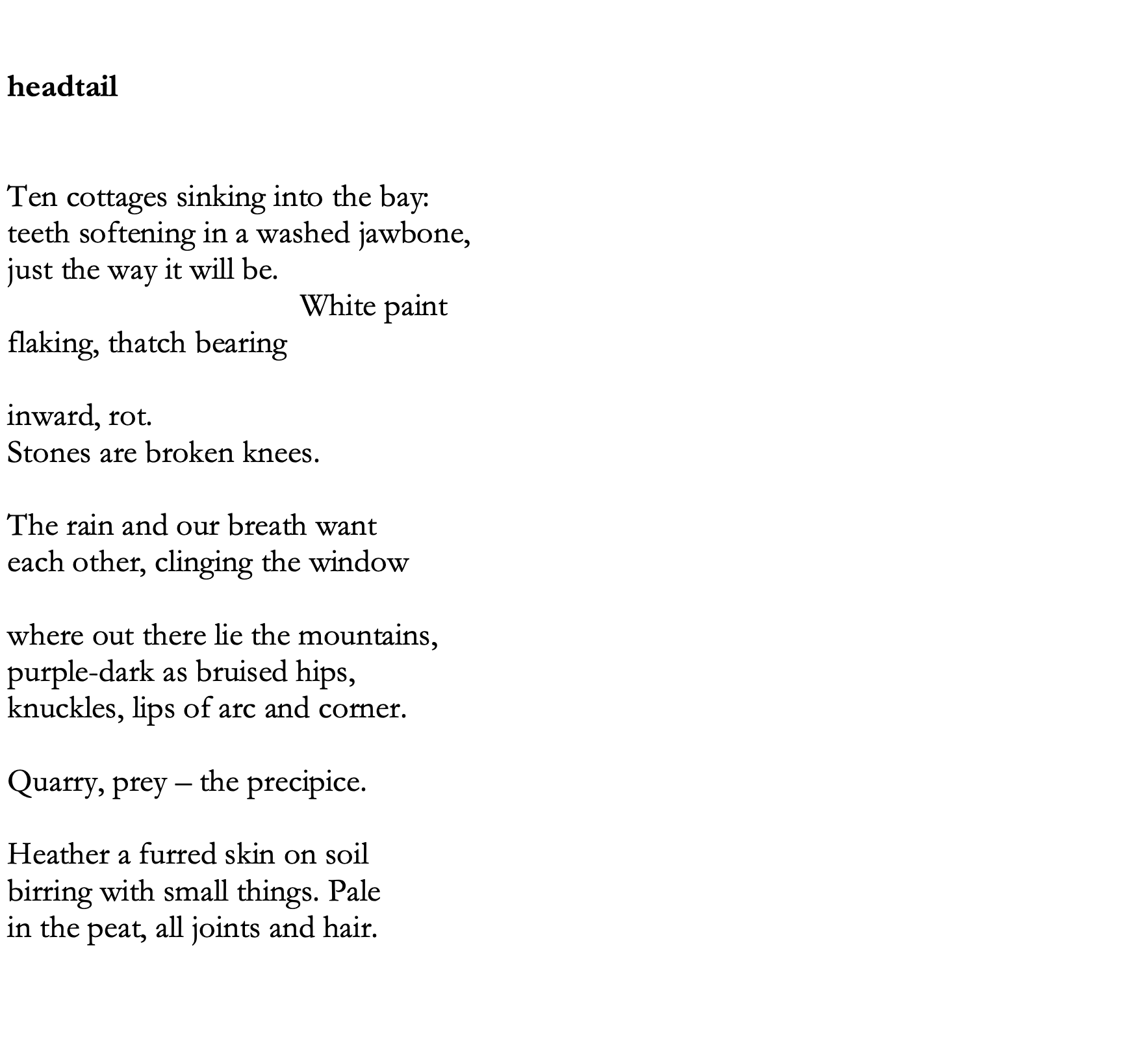CV
Publications
2024 – ‘missed connections’, poem inspired by AI autotranscription misunderstandings, CWYR Zine
2024 – ‘unflock’, four-part experimental poem, Strings 1: dreams jangling with lost connections
2024 – ‘Arrested Octopus’, art writing / experimental writing, Caesura anthology, Pala Press
2023 – ‘strawberry squid’ + ‘insatiable wriggler’, Brilliant Vibrating Interface, an anthology of queer poetry, SPAM Press
2023 – ‘Being is a tender strength’, art writing, Prototype 5 anthology, Prototype Press
2023 – ‘THE FLESH, THE MESH, THE MUSHROOM’, collaborative essay with Nina Hanz, MAP Magazine
2023 – ‘As Silica’, poem, Eight Fires anthology, Dark Mountain
2023 – ‘Evolving Food Traditions’, conversation with Maia Magoga for ACV Magazine, Tradition
2023 – ‘the cat which is wild, savage, or of the woodlands’, creative prose, FDBNHLLLTTFMOURNING, Sticky Fingers
2023 – ‘Vergankelijkheidswake’ / ‘Guarding Transience’, drawings with Miek Zwamborn + poetry, De Gids
2023 – ‘Palettes of the Gods’, art writing/essay, My Daughter Terra anthology, ed. Nina Hanz, Plaintiff Press
2022 – Mycoglossia, poetry pamphlet in collaboration with Nina Hanz, HVTN Press
2022 – ‘She is the knot that always slips’, prose poem, Daisyworld Magazine Issue 005: Dangerous Depths
2022 – ‘www.dreamoracledivine.xyz’, experimental text, FDBNHLLLTTFPARODY, Sticky Fingers
2022 – Feature on Libby Heaney, CLOT Magazine
2022 – Interview with Howardena Pindell, Twin Magazine
2022 – ‘Forget the Metaverse; It’s Time for Artists to Enter the ‘Mutaverse’, ArtReview
2022 – ‘On Alberto Balsam’, poetry, You’ve Got So Many Machines, Richard!, an Aphex Twin anthology, Broken Sleep
2022 – ‘Through Hagstones’, drawing, Blue House Journal: Stone
2022 – ‘seawitch, I watch you’, experimental essay, SPAM Plaza
2021 – ‘Inscribing the Devil Fish’, essay, 3:AM Magazine
2021 – ‘membrane exchange’, The Digest Reader, zine supported by TACO!
2021 – ‘wolfish / this heart is’, poetry, FDBNHLLLTTFNOCTURNAL, Sticky Fingers
2021 – ‘Yeast’ + ‘Headtail’, poetry, Tentacular Magazine
2021 – ‘Grinding, slicing, tearing’, experimental fiction, DreamsTimeFree: Soft Tissue, TACO!
2021 – ‘Meat Dreaming’, experimental drawing and writing zine, Sticky Fingers
2021 – ‘(un)like death warmed up’, essay, Dark Mountain 20: Abyss
2021 – ‘SLIMY, STICKY, SWEET’, essay and video (from conference presentation), SPAM Plaza
2021 – ‘As Syrup’, poetry, AWW-STRUCK, Poem Atlas
2021 – ‘Three Poems’, FDBNHLLLTTFHORROR, Sticky Fingers
2021 – ‘Intertitles’, experimental writing anthology review, MAP Magazine
2021 – ‘Leaves, alive and otherwise’, essay, Still Point Journal
2020 – ‘Sharing Grounds: A Commonplace’, review, 3:AM Magazine
2020 – ‘Contagion Closer to Animal’, poetry collaboration with Nina Hanz, ARC
2020 – ‘Distant Tenderness: Molly Morphew’, review, ArtDaily
2020 – ‘A pissing match over tigers’, long-form poetry, The Pluralist
2020 – ‘Pipe Down’, fiction, Attention anthology
2020 – ‘Contact’, photography series, ARC Magazine
2020 – ‘Heal Underfoot’, essay, Simulacrum Journal
2020 – ‘Eco-Visionaries’, long-form review, Art & the Public Sphere
2019 – ‘Primordium’ – performance script – Arvid&Marie
2019 – ‘Turning’, letter, Letters to the Earth anthology, HarperCollins
2019 – ‘Welcome to Elsewhere’, essay, NOIT Journal, Flat Time House
2019 – ‘Weighting’, poetry and prose, Le Grand K anthology
2019 – ‘The Present Moment: Sonic Acts’, review, Aesthetica
Commissions
2023 – ‘Delimiting’, prose, To Be We Need to Know the River
2022 – ‘Surface as vessel’, poetic essay, Dark Mountain Issue 22 – ARK
2022 – ‘Undergoings’, long-form essay, Pala Press: Subteranne
2022 – ‘From the Ends of the Earth’, essay, IOU Theatre
2022 – Four poems for accompanying publication, Sink or Float, solo exhibition of Jessica Wetherly, Aspex Portsmouth
2021 – ‘fable’, text for catalogue of Jessica Wetherly’s exhibition, Tele(gram): frequencies of the forest (Bilbao)
2021 – ‘boundless’ + ‘transmission’, poems for Pollination’s refugees welcome campaign, Open Culture: No Borders
2020 – ‘Gently as our days bite’, 11-part micro-fiction series, Robert Young Antiques
2020 – ‘The Best Park Ever’, hand-drawn map and text, HORRID! Covid 4: The Park
2019 – Ground Up, 18-minute audio work commissioned by ICA / BBC New Creatives
2019 – ‘<>’, text response to Jessica Wetherly’s RCA MA show, Laboratory
Events + Workshops
2023 – Attendant Writing, first workshop at LOT Projects, second workshop at Glengall Wharf Gardens, London
2023 – Sporing Poetry with Nina Hanz, collaborative eco-poetry workshop at Floating, Berlin
2022 – HUM MURMUR MUTTER, five-week experimental writing course, Camden Art Centre, London
2022 – Inside Your Mouth Are Mountains, three-week experimental writing course, Camden Art Centre, London
2021 – A More-Than-Human Story, ecological writing workshop, Baker Street Productions, online
2021 – Gut Feelings: Voicing the Visceral, three-hour experimental writing workshop with Esme Boggis, TACO!, London
2019 – You Enter Into a White Room, three-day art writing workshop with Harri Welch and Lucy Holt, AcrossRCA, London
2019 – Playing Houses, (project manager) three-venue day programme, Flat Time House, London
2016 – *immersions, curating screening series spotlighting Levantine moving image artists, Al Ma’mal Gallery, East Jerusalem
Group Exhibitions + Showcases
2023 – Drawing In, collaborative drawings with Miek Zwamborn within open call element of exhibition, An Tobar (Isle of Mull, UK)
2022 – JE SERAI t.a.on meilleur.e.x ami.e.x, drawings + writings, Non-Étoile (Paris, FR)
2022 – Octopus’s Garden, recorded poetry for group exhibit with Knockvologan Studies, De Vishal (Haarlem, NL)
2021 – Magical Octopus Sequel, cyanotypes + audio for group show, Knockvologan Studies (Isle of Mull, UK)
2020 – Small Talk, My Animal, curatorial text + audio piece for group show (online)
2020 – Letters in Lockdown, letter on lungs read by Jessica Hynes for Culture Declares (online)
2020 – Current Transmissions, Ground Up shown as part of ICA x New Creatives showcase, ICA (London, UK)
Residencies + Laboratories
2023 – Nine-day self-directed micro-residency, Footnote Centre for Image and Text, Belgrade
2019 – Cartographies of the Vanishing Now, artist laboratory with FIBER, Amsterdam
Readings, Presentations + Panels
2024 – Mushroom Church with Modern Biology, Christ Church Cathedral, Vancouver
2023 – Special Edition: Non-Human Poetry, National Poetry Library, London
2023 – Prototype 5, anthology launch and showcase, The Ivy House, London
2023 – Formas Mutatas, an evening of performances interpreting Ovid’s Metamorphoses, Asylum Chapel, London
2023 – Soundgate Belgrade, live broadcast by the Lumpen Station (Switzerland), from Footnote Centre, Belgrade
2022 – Slime, Sublime, Sublimation,with Esther Leslie, Krystle Patel and Maybelle Peters, The Horse Hospital, London
2022 – Autumn Party, Sticky Fingers Publishing, The Glory, London
2022 – Still Point Writers’ Showcase, Reference Point, 180 The Strand, London
2021 – Winter Party, Sticky Fingers Publishing, The Glory, London
2021 – A Handful of Sinister Scenarios (AKA Jump My Bones), opening, Florence Trust, London
2021 – Mouth Parts, group show curated by Molly Morphew, St Margaret’s House, London
2021 – Write the Earth, Baker Street Productions for Reading Climate Festival, Reading
2021 – Aww-Struck: Creative and Critical Approaches to Cuteness, University of Bristol + Royal Holloway, online
2020 – Creature, Stranger, Monster, Other, panel discussion chaired by Dame Marina Warner, RCA2020, online
2020 – Obsessed! panel discussion chaired by Sally O’Reilly, RCA2020, online
2020 – Attention! anthology launch, Morocco Bound, London
2019 – ‘Taken Lightly’, Le Grand K broadcast by thisistomorrow, World Metrology Day, Science Museum, London
2019 – Le Grand K anthology launch, Gossamer Fog, London
Achievements
2024 – Longlisted for the Upstart & Crow Stories from Here residency and grant (CA)
2023 – Drusilla Harvey Access Grant (UK), for Sporing Poetry workshop at Floating, Berlin (DE)
2020 – Shortlisted for the Interstices Novel Commission, Book Works (UK)
2019 – New Creatives Commission for Ground Up, Institute for Contemporary Art x BBC (UK)
2016 – The Holland Scholarship, Dutch Ministry of Education (NL), merit-based funds to study at McGill University (CA)
Education
2020 – MA Writing, Royal College of Art (UK)
2017 – BA International Studies, Leiden University (NL)
2013 – International Baccalaureate
~~~~~~~ page coming into existence soon ~~~~~~~
~~~~~~~ page coming into existence soon ~~~~~~~
~~~~~~~ page coming into existence soon ~~~~~~~
~~~~~~~ page coming into existence soon ~~~~~~~
~~~~~~~ page coming into existence soon ~~~~~~~
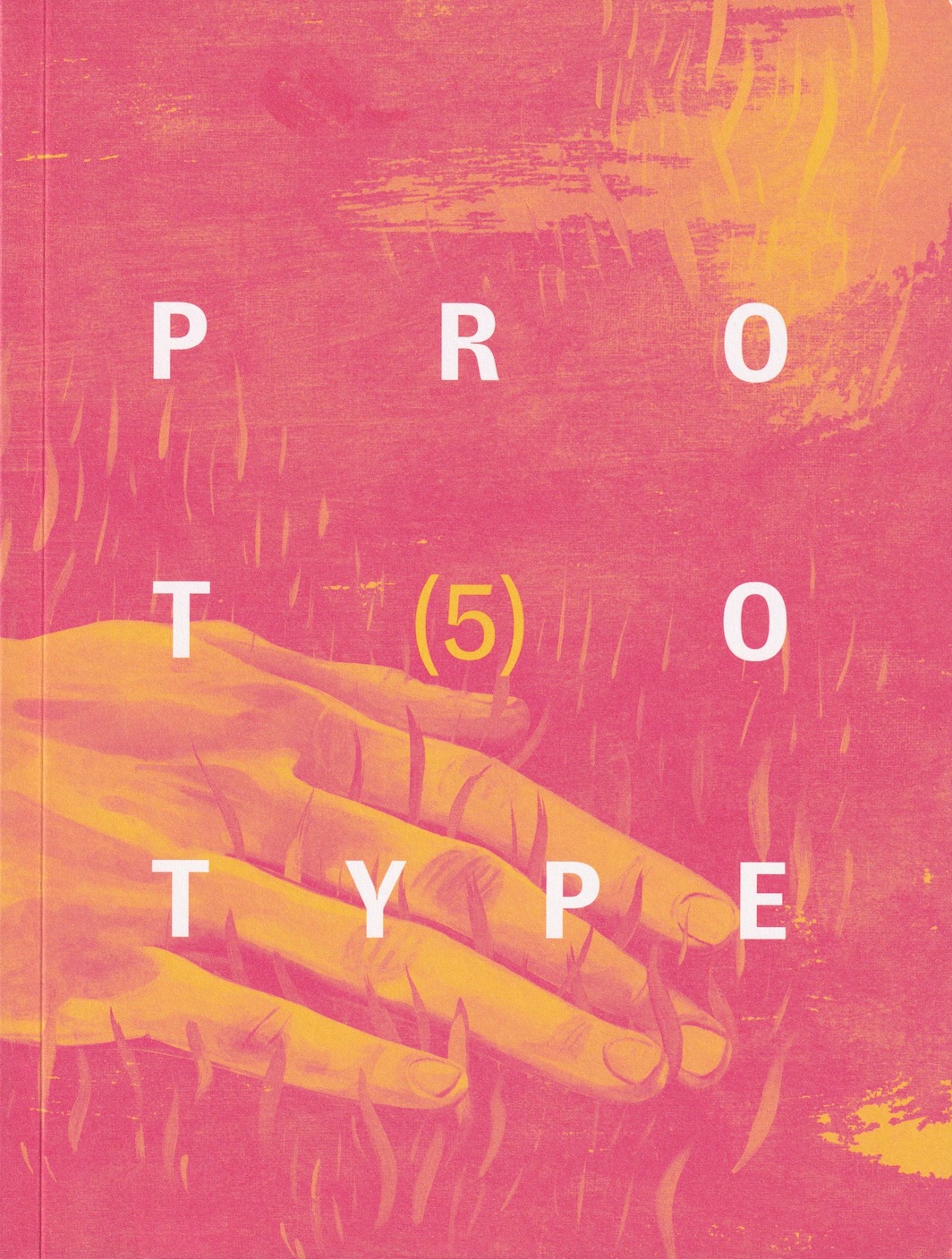
Image: anthology cover.
Being is a tender strength
Essay on vulnerability, intimacy, care, pain, corporeality, and transmissions, all guided by the soft-bodied octopus. Published in the fifth annual anthology of the wonderful independent press, Prototype. To be included in this collection was a real honour. ‘Being is a tender strength’ is part of Shapeshifter (FKA Cephalopodomania).
Extract:
On the day when I go to get a copper contraceptive coil inserted into my womb, this unseen part of myself – its dimensions mysterious to me – must first be measured with a sound, and a gut-lurching prod as its thin plastic proboscis hits my uterine wall. This sound is named after another: the rope that mariners once used to map the sea, dropping a weight to the bottom over and over again.
Firmly asserting an opinion on its new resident, my womb demonstrate its discontent, contracting in earnest attempts to push the coil – a foreig body – out of internal territory. This is, apparently, normal. But suddenly the pure muscularity of this eight-centimetre-deep part of me is palpable, broadcasting protest-laden waves of back-curling pain, wrenching on ) nerves that seem to reach deep into every other mass in my torso. Ultimate proof that bodies and their organs can think and speak, this time in a literally visceral language.
This mild cyborgification of myself, this adaptation, comes mid-way through my descent into a gentle obsession with collecting and writing octopuses, tracing their lineage through dusty archives, memes and synaesthetic digital art. And in my days of aching adjustment, my partner brings me a soft toy octopus. Dusky pink, head the size of a fist. One of a kind that had popped up in children’s shops, bookstores and gift boutiques in Edinburgh, London, Amsterdam, Berlin. Wherever I went, members of this close-knit JellyCat family peeked out from shop windows, inaccurate yet charming smiles shining from the pink and teal of their ultrasoft faces. And now mine sits on my belly, with the heartfelt gaze of pure love that toymakers have spent centuries mastering with the most minimal application of small, tight stitches. Eight springy arms corkscrew out over my skin, peritonea and deep, throbbing tissues. The way I love this small and incongruously fleecy inanimate object initially felt regressive – a soft toy. But he stands in for care and kindness, for my partner’s touch.
Months later, my colleague knits an octopus, just to occupy her hands as she watches a film, then brings her into work for me, the increasingly indiscreet collector of octopuses. Purple and yellow, the little crocheted animal sits still on my desk, goggling encouragingly at us all, until another colleague bring his young baby to visit. Perched on a spinny chair that is comically over-large for her, the one-year-old baby grips and shakes the little octopus, chirruping and chewing on her limbs in gummy appreciation.
Knitting is making a soft network. Wiring warmth.
That year, as we drive home for Christmas, my stepmother, a retired nurse, tells me about Octopus for a Preemie, a charity that asks people to knit, crochet and donate soft toy octopuses to maternity wards for premature babies. The octopuses’ many soft arms, each like an umbilical cord, reassure the tiny, early humans in their incubators. Sleeping with these arms gripped in their hands, babies are less likely to tug on or pull out their lifelines in distress or confusion, thinking that these tubes still tether them to a parent.
The idea that a small, knitted octopus could help to save a human baby’s life seems remarkable, like a children’s story. There is a strange and strangely heart-breaking intensity in how this figure of another animal tangles up with human life, cradled at its most vulnerable.
[...]
_________
Prototype 5 features contributions from Rojbîn Arjen, Alex Aspden, Ed Atkins & Steven Zultanski, Mau Baiocco, Claire Carroll, Hal Coase, James M. Creed, Iulia David, Nia Davies, Fiona Glen, Olivia Heal, Emma Hellyer, Hannah Hutchings-Georgiou, Rowe Irvin, Sasja Janssen (trans. Michele Hutchison), Bhanu Kapil, Sharon Kivland, Jeff Ko, Prerana Kumar, Grace Connolly Linden, Dasha Loyko, Nasim Luczaj, Ian Macartney, So Mayer, Catrin Morgan, Ghazal Mosadeq, Connor Oswald, Kashif Sharma-Patel, Helen Quah, Dipanjali Roy, Leonie Rushforth, Stanley Schtinter, Lutz Seiler (trans. Stefan Tobler), Madeleine Stack, Malin Ståhl, Corin Sworn, Olly Todd, Yasmin Vardi, Kate Wakeling, Nathan Walker, Ahren Warner, & Stephen Watts.
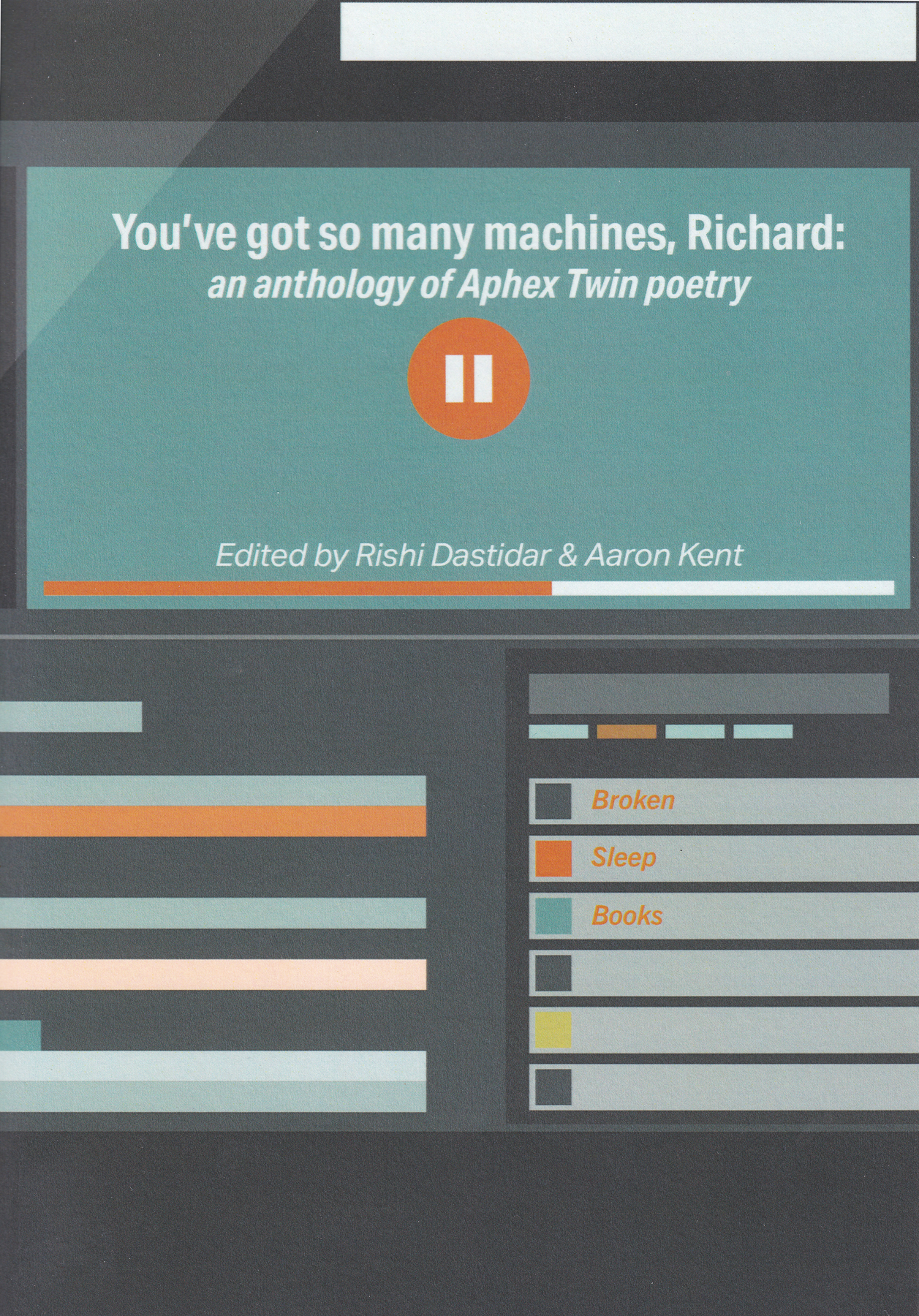
Image: anthology cover.
On Alberto Balsam
Poem published in Broken Sleep’s 2022 anthology on Aphex Twin / Richard D. James / AFX / Polygon Window, You’ve got so many machines, Richard! I wanted to use words to make a droplet of the nostalgia-unspooling mood of Aphex’s song Alberto Balsam. I composed this poem largely from fragments of YouTube comments – reassembling feelings and thoughts shared by strangers into a flow that fits my own sense of the song.


yeast + headtail
Two poems published in Tentacular magazine Issue 8: ‘Transitions’, guest-edited by Isabelle Baafi. ‘yeast’ can also be found in Mycoglossia.

Images: from the start of the BVI ‘digital sibling’.
insatiable wriggler + strawberry squid
Two poems published in late 2023 as part of Brilliant Vibrating Interface, an anthology of queer poetry from SPAM Press. BVI exists both in book format, and as the ‘digital sibling’ – an interactive, multimedia website. Bringing together work by a generation of ‘digital natives’, the project continues the concerns of Scottish poet Edwin Morgan, including ‘queerness, experiment, hybridity and technology’.
‘insatiable wriggler’ is an ekphrastic response to the slinky orange form within Louise Bourgeois’ 1996 sculpture, untitled. ‘strawberry squid’ addresses the animal of its name, a deep sea creature that is only made visible, from my distant vantage point, by the entrancing videos and hyper-detailed images that were washed up in my hands by the algorithmic tides of the internet.
Extracts from ‘insatiable wriggler’:
bright * as * open * pumpkin
or tangerine tiger or peeled peach
bum tucked under: neat in pleat and patch
slinky
wicked
impish
one
coiled like lamprey in pink bucket, untrusted
in that lithe, sly way
[...]
torso writ as a stem of twisty
ruckles, tusled furtive
(quick squeezed giggle!)
[...]
prehensile slendrous tensile tickling trunk
the suspect is so fiendish sweet:
an imposter trailing puzzled perk
lurid and changed through every frame
or tangerine tiger or peeled peach
bum tucked under: neat in pleat and patch
slinky
wicked
impish
one
coiled like lamprey in pink bucket, untrusted
in that lithe, sly way
[...]
torso writ as a stem of twisty
ruckles, tusled furtive
(quick squeezed giggle!)
[...]
prehensile slendrous tensile tickling trunk
the suspect is so fiendish sweet:
an imposter trailing puzzled perk
lurid and changed through every frame
Fragments from ‘strawberry squid’:



Image: Bernard Hermant, via unsplash.
unflock
Four-part poem based on the dynamics, sounds, textures, and movements of bird vocalisations. It was published in March 2024 in the first issue of Strings magazine, Strings 1: ‘dreams jangling with lost connections’. This poem owes part of its material to Jim Flegg’s humble Collins Gem book, Birds.
Extracts:
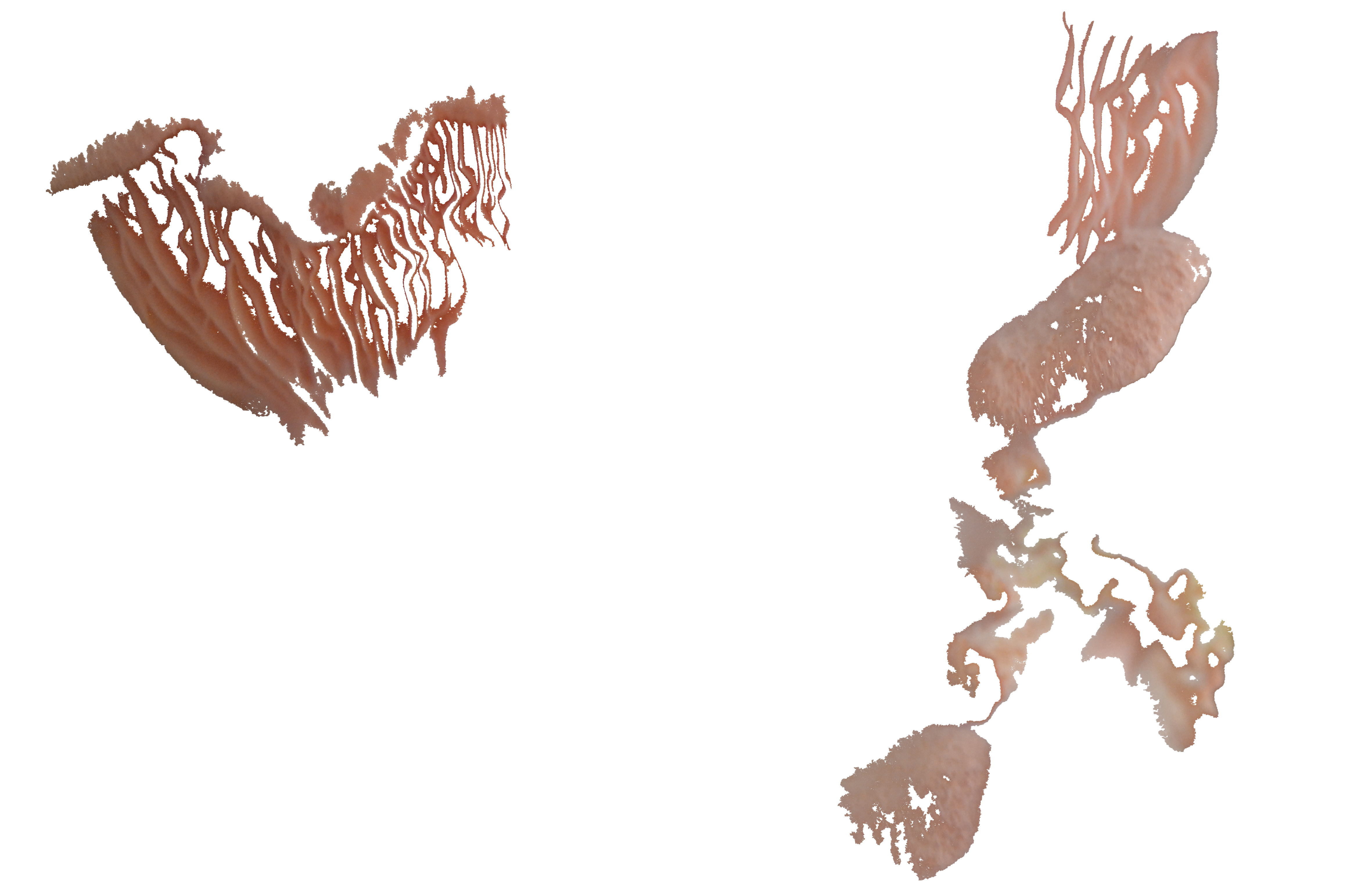
Mycoglossia
Poetry pamphlet written in deep collaboration with Nina Hanz, and published by HVTN Press in December 2022. Mycoglossia is an experimental collection of ‘mushroom tongues’ – an attempt to break conventions in poetic form – an enticement of non-human voices from the page.
This collection started with the contagious shared idea of making poems that ‘moved like spores’. It grew in a shared Google Doc during the early 2020 COVID-19 lockdown, found form as a 6-page magazine spread, and then blossomed into a 40-page pamphlet. You can buy it from our UK-based publisher, or from ChertLüdde Books in Germany, which offers international shipping. Its illustrations and cover art are by the talented Zsófia Jakab.
Mycoglossia has been read and featured at a range of events, from its launch in December 2022 at ChertLüdde Gallery, Berlin, to Mushroom Church. This nurturing evening of shared sound, words and connection to nature was convened on 1 March 2024 at Vancouver’s Christ Church Cathedral, by Modern Biology (Tarun Nayar), a maker of mushroom music.
The collaboration between Nina and myself is ongoing, and we have expanded on our ideas in various ways. In February 2023, we presented a lecture at the National Poetry Library, London, as part of a special evening on writing poetry with more-than-humans. In August 2023, we ran a collaborative experimental writing workshop called Sporing Poetry at Floating, Berlin, to share ecology-inspired techniques for exchange and co-writing with others. In September 2023, we published an experimental essay, ‘The Mesh, the Flesh, the Mushroom’, with MAP Magazine, bringing our process to life. You can also read about the collection in the context of writing with non-human voices in this article. We are open to collaborations with scientists, artists, publications, and more, so please reach out if you would like to share an idea.
‘in edges, everything’ from Mycoglossia:
you bubble up nightly
an anyone as many-one
your union of tight-knit weavers
advancing on parallel
trama-tracks: rootshape
of hope and hyphae
feeling out futures, you thrive
on time’s thick margin
cryptic and cosmopolitan
beetle-skinned in chitin
born with all your cells; mitotic,
they swell rather than splitting
inheriting everything, yours
are the wide-webbed worlds
undreamt by our anarchists:
earth-turning matrices, a source-share
subversive
a true underground
Endorsements:
Mycoglossia: Words that branch, connect, search, digest, swell, tunnel, rise, and reduce; words that sit uneasily at the edge of names; words that unexpectedly explode in generous fruiting bodies, littering the landscape with bounty. This is a collection to savour.
—Anna Lowenhaupt Tsing
Reading Mycoglossia is like lifting a magnifying glass to the life of fungi. Here is a poetics that bursts forth, unstoppable in its mesmeric multiplicities – rightly and wonderfully matching its subject matter. As the mushroom world voices itself – ‘We, a single letter / swiveled to me’ – Fiona Glen and Nina Hanz propose a radical revision of the lyric that is at once wildly lavish and ‘trimmed vivid’. Be prepared for the extraordinary.
— Isabel Galleymore
Mycoglossia is an exploration and poetics into a sense of the understory, and the ways in which it is both inhuman and alive. These poems, like a force of nature, offer something remarkable: a journey into and of the many layers of being.
— Aaron Kent
In Mycoglossia, Glen and Hanz utilise mushroom imagery from spore to meal and beyond in order to take the reader through a wider exploration of language, connection, and what exactly it might mean to be ‘alive’ in the first place. Lines such as “what is a mushroom, / if not a nomad?” work together with form and space to create a forceful collection of work which highlights unrelenting nature in all its fungal glory.
— Sean Wai Keung
Mycoglossia has a palpable energy plunging the reader into the mystical world of ‘enflaming fairies’ and the rituals of the ‘seven-flowers’ and ‘seven disciples’. The poems are urgent and vital confronting the horrors of the Anthropocene and climate emergency: the ‘clotted’ soil, the forest fires, and the ‘burnt, bleached, ripped’. Fiona Glen and Nina Hanz have created a collection with an almighty conscience, a scientific examination of life under the microscope. The reader looks to the petri-dish, the fungi, the algae but also their own human body. This is as much about the world around us as it is about us and our ‘cracking toes’ and flaking skin. The reader is awakened to both the beauties and horrors of the past, present, and our impending future. Reading this collection in the twentieth-first century, we are the ‘Dead-Man’s fingers’ which must find a way to ‘rise again’. Formidable, irresistible, and unforgettable.
— Karenjit Sandhu


Image by Fiona Glen
SHAPESHIFTER: Tracing the Cultural Octopus
A lithe and playful book which explores the surge of octopus imagery across contemporary culture, and untangles the many meanings these animals hold.
Since 2018, I have been collecting and analysing representations of octopuses (and their relatives, squid and cuttlefish). I see these popping up everywhere: in art, literature, pop culture, marketing, tech, philosophy, and beyond. Cephalopods – this group of animals – are chameleonic, mesmerising and intelligent in a radically different way from us. It is easy to become obsessed with them, and they have long been used as powerful and mysterious symbols. As science reveals more about octopuses in particular, there has been an explosion of people using them to express their ideas – and, in an even more fascinating way, their identities.
How we represent animals usually says more about our own society and beliefs than about the animals themselves. Octopuses are caught up in gender, race, sex, religion, politics. SHAPESHIFTER asks how – and why – they came to simultaneously stand for alien swarms and awkward loners, queer freedom and corporate monopolies.
Like an octopus, these meanings are often slippery and shifting. To track them, my thinking and my writing also needed to transform. As it follows my research, SHAPESHIFTER mimics the octopus by taking on different forms. On the journey, we find soft silicone robots, enormous pink protest floats, and interstellar think tanks full of dolphins.
SHAPESHIFTER is energetic, colourful and curious, drawing inspiration from the trickster animals that it traces. This creative and critical non-fiction book invites readers to open themselves up to new ways of looking at – and thinking about – how we represent animals, and ourselves.

Through the salted waters they come, those loose-legged shapes with their unmistakable silhouettes forever changing. Through cyberspace they clamber, these spiders of the sea, these dream-like spooks who shift through every colour – underwater chameleons, with skin smoother than scales. Through literatures and caricatures, brand books and grassroots movements, they float and flicker in letters, pixels, ink, crystals. What is the trace – the lineage – of creatures like these? Are their meanings as unfixed as their form, their symbolisms as mysterious as their reaching minds? Where do these octopuses lead?
Each opening is a new whisper: here be krakens. Here be dreadful monsters and utopian spirit-guides. Here be witches and women, aliens and alter egos, mystical icons and mirror images. Here be hope and fear, appropriation and obsession, the familiar and the other. Here we are, with our fellow beasts.
___
Read an excerpt which investigates insecurity in the reckoning of monstrosity and otherness through the squid and octopus drawings and writings of HP Lovecraft, with the occasional detour into Pink Floyd gigs and Pirates of the Caribbean). Published December 2021 by 3:AM Magazine.
Read an excerpt from the project in which I pay tribute to Disney’s Ursula as a queer octopus outsider. Published by Still Point in 2020, and by SPAM in 2022.
Watch me reading an excerpt from the project in which we meet the octopus as a fantastical and entirely real being (available via RCA2020 Grad Show Vimeo).
Find an extract on Extinction Rebellion’s giant pink protest octopus, Jeanne-Claude, in Caesura, an anthology on stoppages from Pala Press.
____
This project began as Cephalopodomania, submitted as my graduating project for the MA Writing programme at the Royal College of Art in 2020. It is still growing new arms and seeking a publisher to give it a physical body in the world.
Images: Fiona Glen
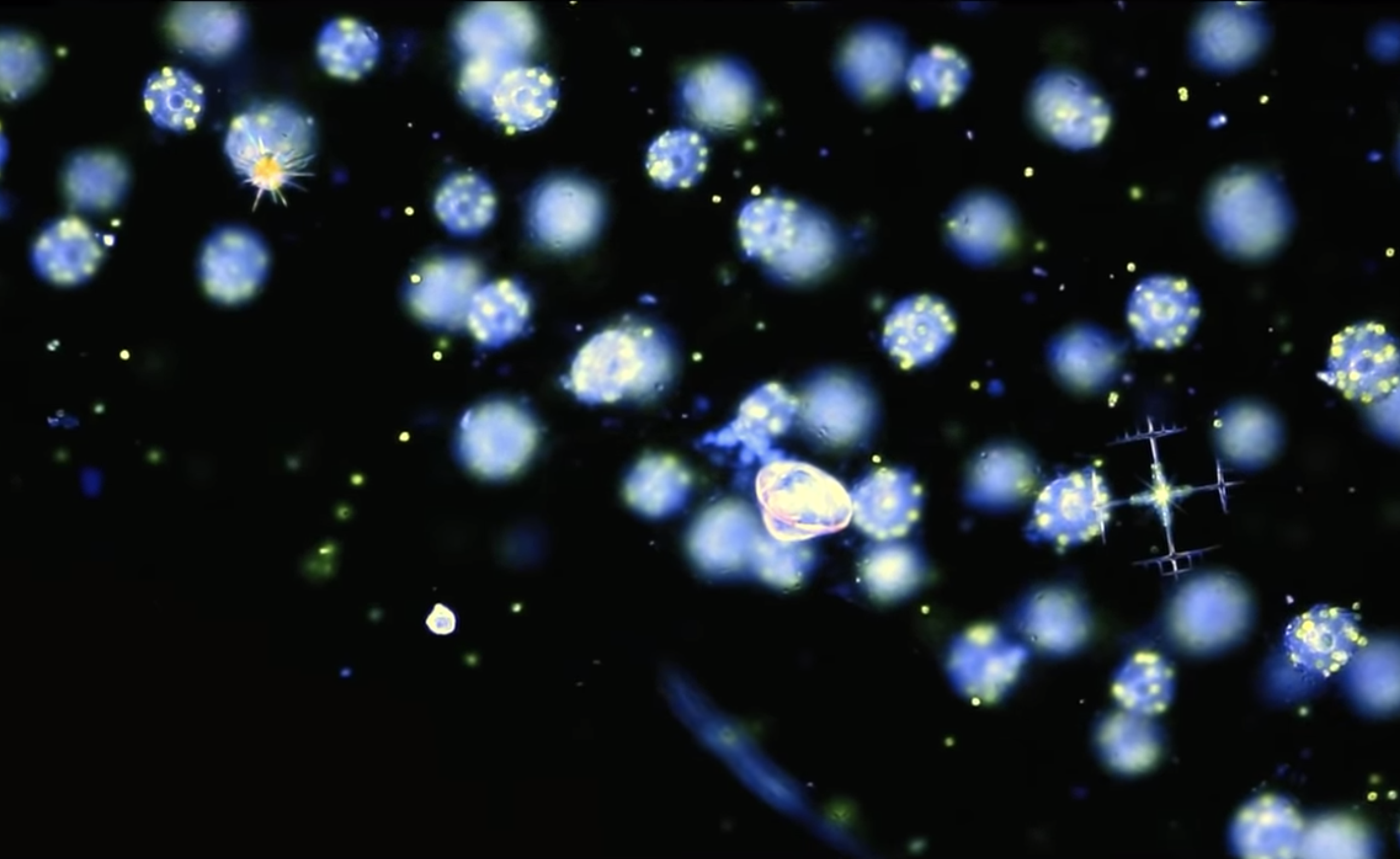 Image: research screenshot from TED Ed (linked)
Image: research screenshot from TED Ed (linked)transient guardians, guarding transience
+ vergankelijkheidswake
A project in two parts, inspired by oceanic phytoplankton and their dialogue with celestial bodies like the moon and sun. Spanning cyanotype prints, poetry, translation and drawing, this project began as an invited response to Hato Press’ prints – which had in turn been a response to a poem – and evolved into a collaboration with Miek Zwamborn.
KNOCKvologan is an arts centre on the Isle of Mull in Scotland. For their Magical Octopus Sequel exhibition in 2021, I produced cyanotype prints and a long-form poem, ‘transient guardians’, in response to risograph prints by Hato Press and my own research into phytoplankton. From Winter 2022 into Spring 2023, I collaborated with artist Miek Zwamborn, one of the founders of KNOCKvologan. Together – across distance – we created a series of experimental and shared drawings that built off my poem and expressed our wonder at the unsung yet world-shaping power of miniscule plankton species, and their intricate beauty. You can find out more about both parts of this project below.
Part 1 – Magical Octopus Sequel Exhibition
Four cyanotype prints created with handpainted negatives, and a 6-minute textural audio track of a poem. Made on invitation for KNOCKvologan’s Magical Octopus Sequel exhibition, first presented from 21-28th November 2021 in KNOCKvologan Barn.
In the Magical Octopus Sequel, artists with connections to the West coast of Scotland were given sections of the award-winning Magical Octopus riso print book to ‘translate’ into new artworks. The Magical Octopus book was itself a collection of responses to images and writings drawn from the landscape and seascape of Mull. These photographs, maps, writings, and drawings had been sent to riso printmakers around the world, eliciting divergent, tentacular expansions from the same initial resources. You can see some of the pages here. For the Sequel exhibition I was invited to work with the eight pages produced by London’s Hato Press, who had created organic, wave-like imagery on a scanner bed in response to a poem by Miek Zwamborn.
Wandering outwards from Hato Press’s exploration of repetition in erosion, printmaking and tide cycles, I considered the relationship between cosmic bodies such as the moon, stars and turning Earth, and the microscopic bodies suspended in our seas. Inspired by the question of ‘who is guarding who’ from Miek’s original poem, my contribution was created in praise of phytoplankton: the collective of photosynthesising microorganisms on which nearly all life in our oceans depends. As the first ever beings to translate sunlight into fuel for life, phytoplankton were the original oxygenators of our atmosphere. To them, we owe our breath – and in concert with the sun that feeds them and the moon that moves the tides, these unsung caretakers of our planetary ecosystem currently retrieve as much CO2 from the atmosphere as all other plants on Earth put together. My spoken poem and cyanotypes combine mythological, cosmological and scientific imagery in an attempt to express this vast yet delicate system of interconnection.

Image: transient guardians, 1 of 4 cyanotype prints, Fiona Glen, 2021
Excerpts from ‘guarding transience’ text:
here, the sun and moon preside over equal
palaces of time
and the sun warms kind through every house
and the sun has cycles swimming in its skin
equal light: equal dark: equal light
...
pure sheer pellucid, they bask all through the photic zone
and burst:
bioluminescing swarming gorgeous eyeless glitter
teeming microscopic mirrorworld
of ribbons.fans.zigzags and stars
a gravitas of spun glass
blind to its beauty
gods under micrograph clarity
an abundance, giving and giving
the unstill moment, again and again
...
You can listen to the full textural poem recording in the Magical Octopus Sequel exhibition, here.and the sun warms kind through every house
and the sun has cycles swimming in its skin
equal light: equal dark: equal light
...
pure sheer pellucid, they bask all through the photic zone
and burst:
bioluminescing swarming gorgeous eyeless glitter
teeming microscopic mirrorworld
of ribbons.fans.zigzags and stars
a gravitas of spun glass
blind to its beauty
gods under micrograph clarity
an abundance, giving and giving
the unstill moment, again and again
...
Part 2 – Living Drawings + ‘vergankelijkheidswake’, De Gids
In autumn 2022, Miek and I started exchanging drawings in which we played with the forms of phytoplankton and diatoms, and the language in my poem. We started drawings and mailed them between London and the Isle of Mull in batches, adding marks and layers on top of each other’s work to create shared images. Allowing ourselves to draw in new and freer ways, we tried to leave behind ideas of the ‘correct’ way to draw, and allow something more energetic and surprising to happen on our pages.
These ‘living drawings’ were published alongside Miek’s Dutch-language translation of my poem by De Gids, on their digital platform, De Internet Gids (DIG). Miek and I had discussed the ‘translation’ of light into life by phytoplankton, and our own attempts to translate their nature across scales and into new forms, so it was fitting to translate the text into another tongue. Over two iterations of our article, we animated our drawing process alongside dual-language poetry, conveying the living and open feeling of our collaboration – a conversation through drawing.
Excerpt from ‘vergankelijkheidswake’:
telkensweergeslingerd
in de lege greep van de zwaartekracht
sterren en planeten kuis uiteen door gewicht en afstand
aangelijnde schepsels
draaien rond assen als mensen verrukt
in de lege greep van de zwaartekracht
sterren en planeten kuis uiteen door gewicht en afstand
aangelijnde schepsels
draaien rond assen als mensen verrukt
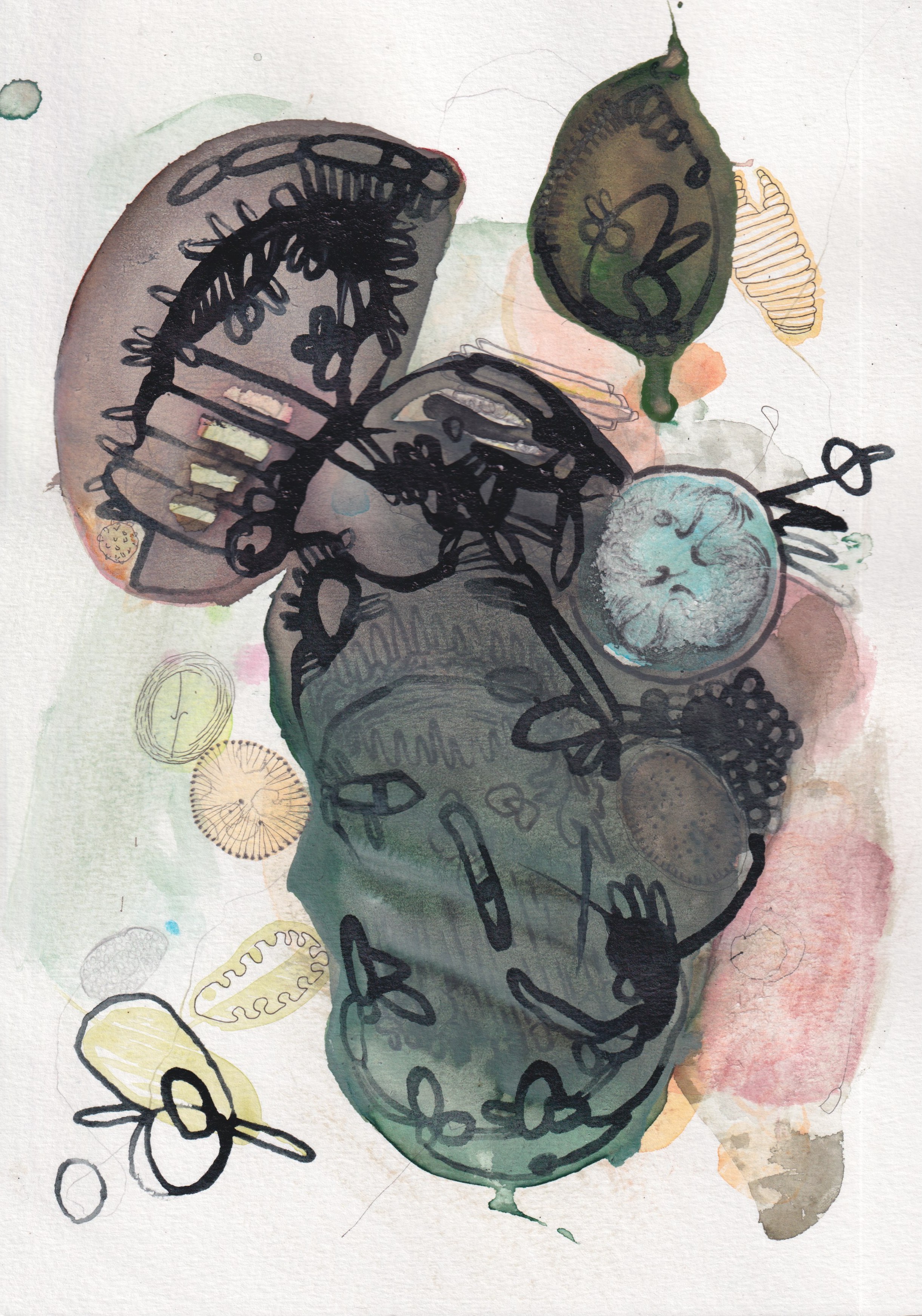

Credits
Magical Octopus Riso was initiated by Jo Frenken, a Maastricht-based risograph printing expert and long-term collaborator of Miek Zwamborn and KNOCKvologan Studies. Participating creators and studios were: Bananafish (Shanghai, CH), Calipso Press (Cali, CO), Corners Studio (Seoul, KR), Endless Editions (New York, USA), Gato Negro Ediciones (Mexico City, MX), Hand Saw Press (Tokyo, JP), Hato Press (London, UK), Issue Press (Grand Rapids, USA), kabinet.studio (Antwerp, BE), Knust (Nijmegen, NL), Quintal Éditions (Paris, FR), Raum Press (Salamanca, SE), Risolve (Lancaster, USA), Sigrid Calon (Tilburg, NL), Wobby.club (Tilburg, NL) and the Jan van Eyck Academie (Maastricht, NL).
Contributing artists to Magical Octopus Sequel were: Filip Andel, Andy Crabb, Derek Crook, Seth Crook, Elaine Dempsey, Rufus Isabel Elliot, David Faithfull, Fiona Glen, Katie Harris-MacLeod, Monica Haddock, Mhairi Killin, Naoko Mabon, Sue Murdoch, Julia Parks, Giles Perring, Christina Riley, Brodie Sim, Jan Sutch Pickard, and Brian Thomas.
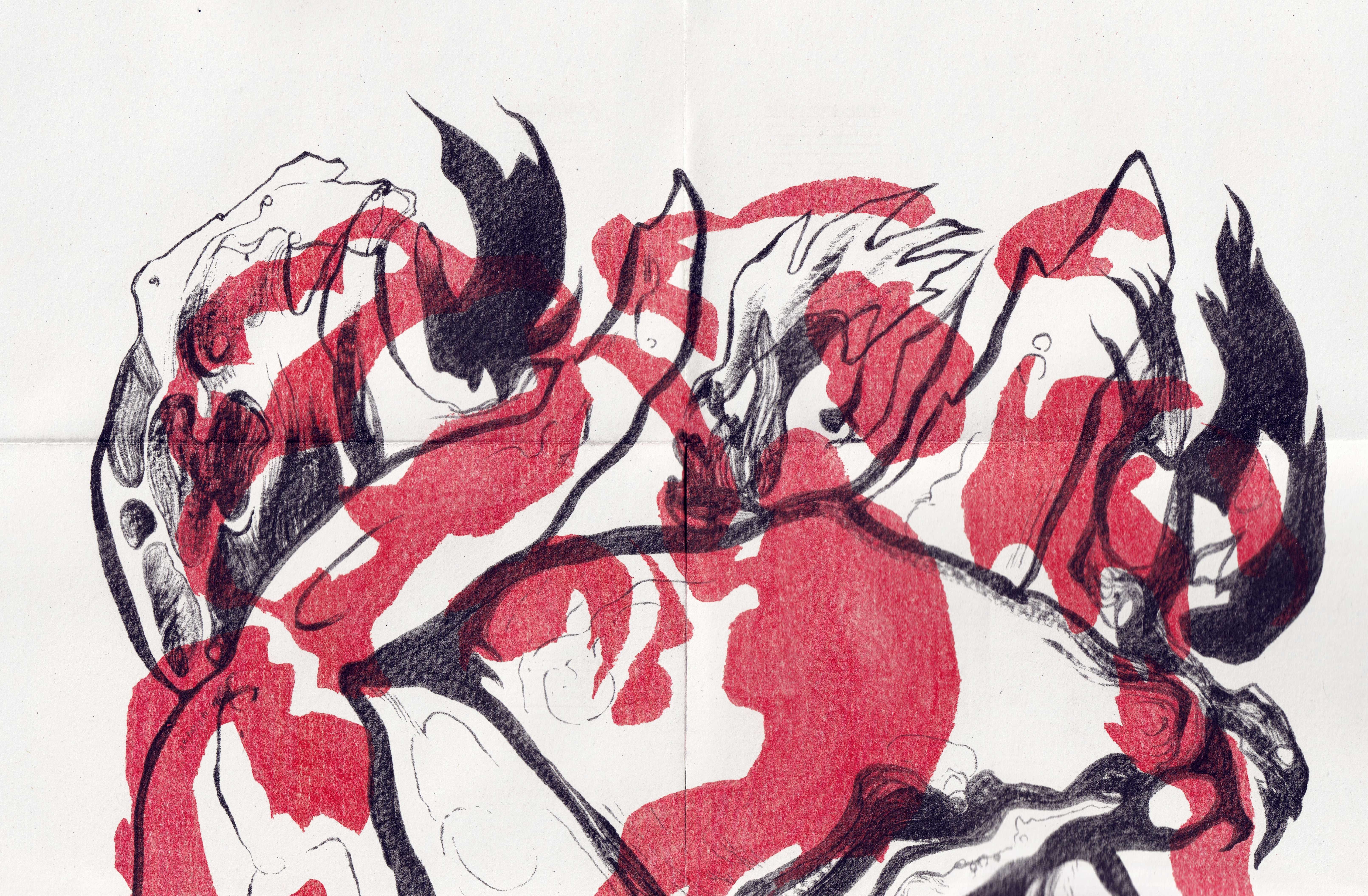 Image: section of Meat Dreaming zine
Image: section of Meat Dreaming zineMeat Dreaming
Micro-zine produced in response to an open call by Sticky Fingers Publishing, combining metamorphic drawings with four short prose pieces. Meat Dreaming explores four dreams of living meat and becoming meat through a series of short, experimental prose pieces, and surreal, often fluid drawings. Uneasy yet tender, strange yet touching, the zine is an open-ended collection of responses to scenes which dissolve the boundaries between a human dreamer and other creatures. Meat Dreaming was produced in one week in August 2021 and was printed by Piggy Bank Shoe.
The zine is a risograph print which folds to 8 small pages, with a foldout A3 poster on one side. It can be bought for £2 from Sticky Fingers here. If sold out, a few copies are available direct from me.

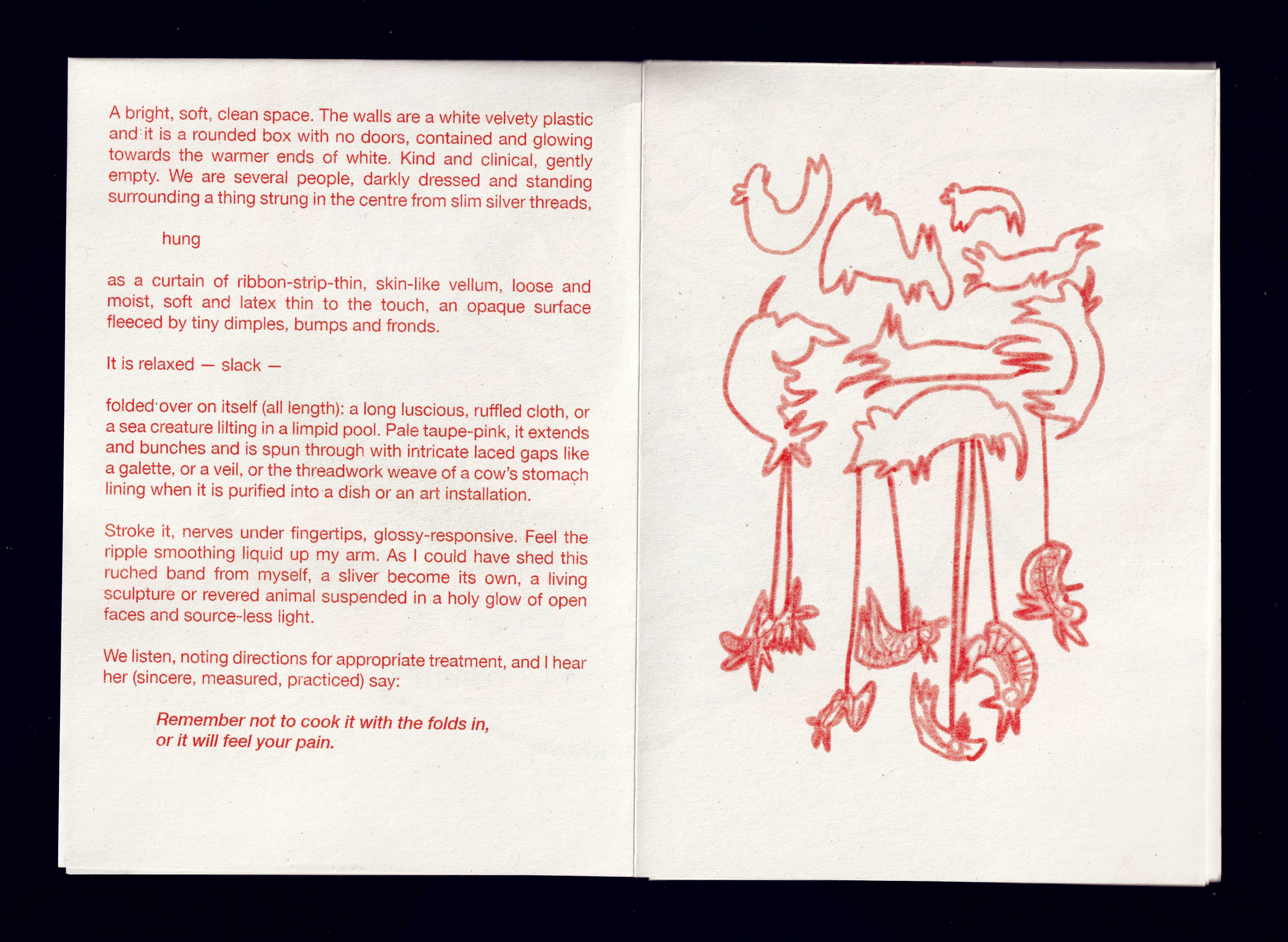
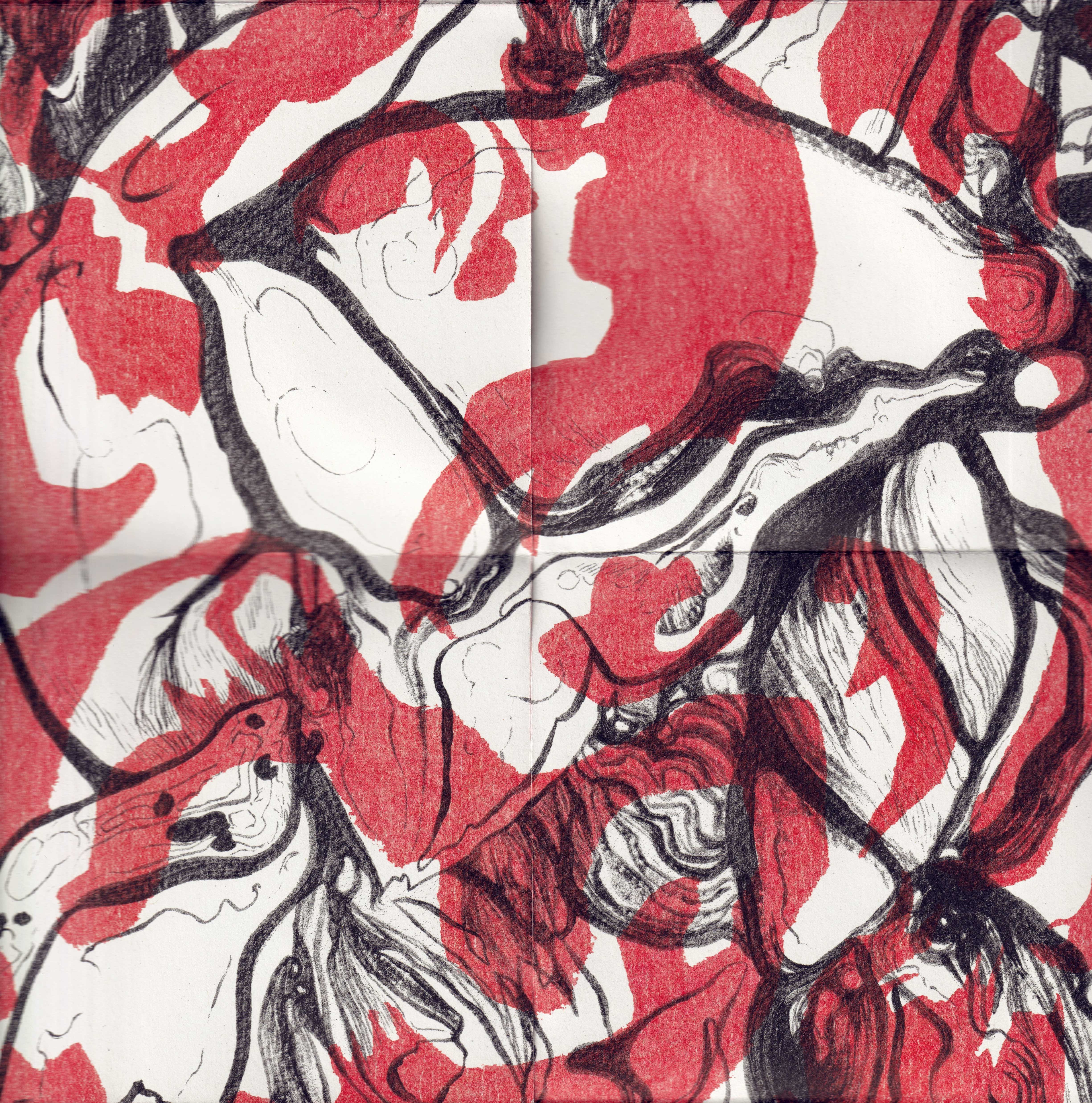
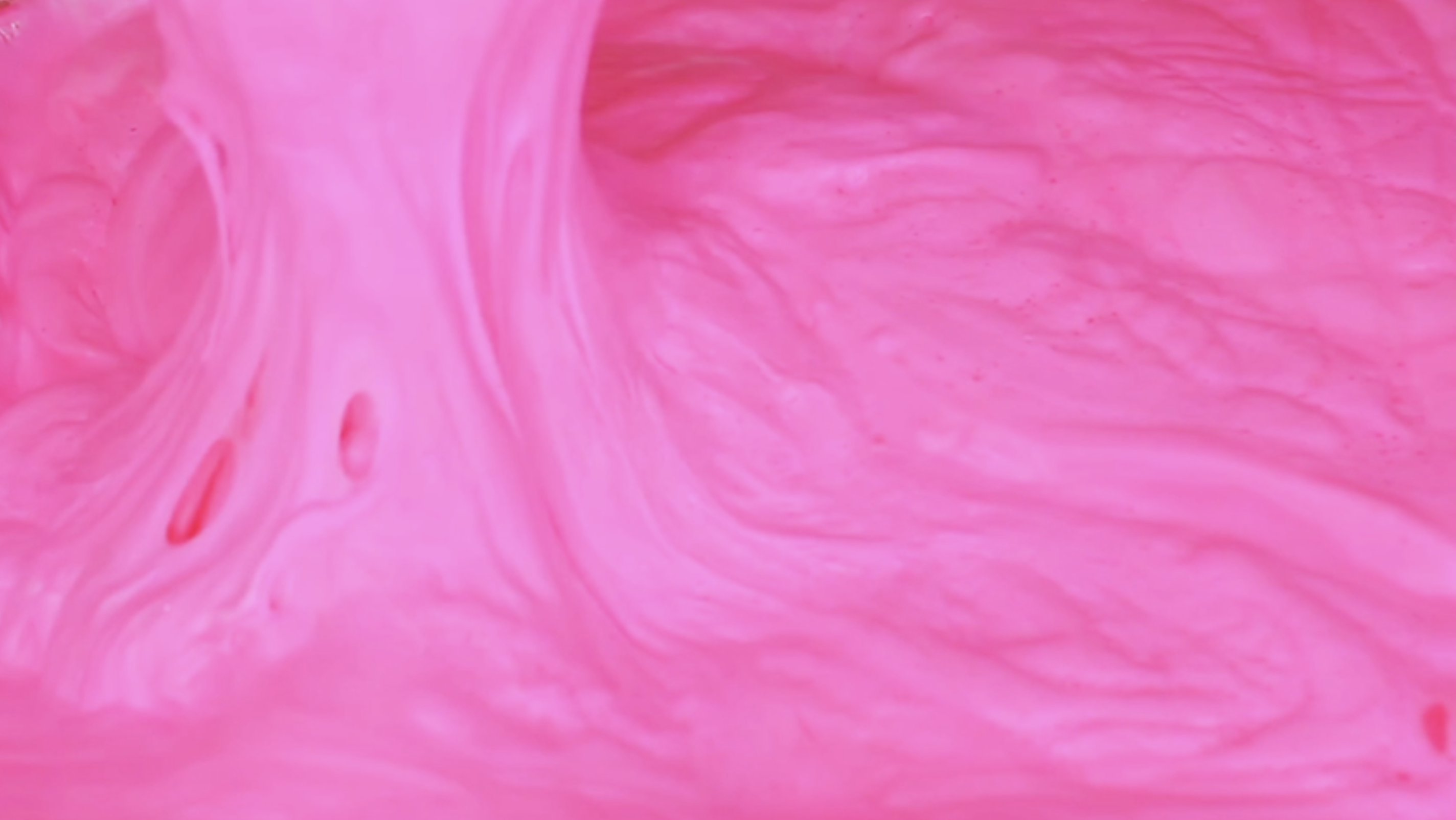
Still from video essay by Fiona Glen, source footage by Yo Yo
Slimy, Sticky, Sweet
Multimedia essay on cute slime, originally commissioned by Aww-Struck: Creative and Critical Approaches to Cuteness, a day-long seminar co-organised by Caroline Harris (Royal Holloway University) and Isabel Galleymore (University of Bristol). Slimy, Sticky, Sweet combines a wandering, mantra-like essay-script with a video essay that brings together found footage of slime making in looped, glitchy, ultra-saturated slow motion. It was presented online in May 2021 as part of Aww-Struck’s panel on Gender and Society. An Aww-Struck publication including another of my texts – an experimental poem called ‘As Syrup’ – was released by Poem Atlas and the University of Birmingham to accompany the seminar.
After having been presented and discussed at Aww-Struck, Slimy, Sticky, Sweet was published in July 2021 by SPAM Plaza as their first video essay, accompanied by an expanded essay. The piece delves into the sanitised and hyperfeminised new paradigm of slime, proliferating through platforms such as TikTok, Instagram and YouTube. In the essay-script, I consider cuteslime through the abject, the excessive, the idealised, the marketised, and the ecologically monstrous. Read, watch and listen to the full piece here.
Excerpt:
[...]
A glimmering trail follows embodiment. Slime in sex and birth and death, hatching and rotting. It is defensive and exposing. Mucus protects – and yet mucus membranes are soft sites of intense transmission. We all ooze. The slimes our own bodies release enter another in-between: the uneasy state between self and not-self.
I want cuteslime to be some kind of reclamation of the feminised abject and the stickiness of being in any body. I want this to be some statement of proud, pink fleshliness — a high-camp assertion that all humans do live with slime, close to ourselves and material things, forever changing, slippery and free. But maybe that’s just what I want to see.
Cuteslime is a fantasy: sanitised, strawberry-scented and shameless. It bubbles up from entrepreneurs, algorithms and influencers, a craze that just won’t calm, signalled by canned giggles and swelling web shops.
Cuteslime is deeply capitalist and deeply clean. It is has left bodies far behind. No chunks, no lumps. This is not secretion. Cuteslime does not seep thin in parts or leave wet marks. It is not organic.
It is synthetic evenness, even when it is pulled out into bubbled ribbons that rip a honeycomb of curves. Pure consistent colour or clarity. It does not have the jellied dangles of raw egg white, or the mottled bands of biofilm in our saliva.
Cuteslime is hyper-aesthetic. Visually delicious. Perfectly suited to the channels which amplify, refine and intensify it. A fragment among a million other images, it is, in itself, fascinating. It needs no context; it is its total meaning.
Endlessly various, cuteslime visibility entices more looking, making, buying, playing. Companies with names like Slimeowy and Kawaii Slime sell it under complex taxonomies: galaxy, glossy, bubble, float, crunchy, clay, unicorn, smoothie, velvet.
Having been a child under contemporary capitalism, I remember what it’s like to uncritically want all the slight, bright mutations of a product — the whole collectible catalogue. Cuteslime oozes forth — creatively, hungrily — from wealth. An encounter between the weird and the market.
Perhaps synthetic slimes can only be cute because we already live among them. Freddie Mason calls ‘gooeyness’ a distinctly ‘modern phase of matter’ in his book, The Viscous. [4] Since the mass extraction of petroleum began, slippery derivatives have proliferated. Slime that is not animal or vegetal but emerges from minerals and industry has become ever-more fashioned to our needs. Lube, LCD screens, lip gloss. Since Sartre wrote on it in 1943, slime has become a far dearer friend. It brings us pleasure, speed and beauty.
Maybe the digital feels less like a cloud and more like slime. Flows gather, bits stick, polluted pools at the sites of extraction grow a rich layer of scum. Slime is a mode of life, a medium of healthy lifeforms. But it is also a signal of ecological stress and distress: the sea snot clogging the Mediterranean, the blue algae choking out lakes, the green drench on a canal flooded with fertilisers. Industrial production is filled with sludges poured into moulds, molten slurries at the bottom of tanks, by-products and leftovers. Slime is the texture of inflow and outflow, of the invisibilised waste from the industrial production of our clean bright devices. Slime moves into and out of our things.
Like capitalism’s, cuteslime’s dirt is displaced from the site of its enjoyment. It is often made of plastics: glue, glitter, polystyrene, and microbeads. In the rare case that somebody wants to recycle synthetic slime, it can be dissolved in lemon juice and vinegar to produce a thin, grey, acid soup that can then be taken to a liquid waste treatment facility. But most of the time, cuteslime is simply binned.
Cuteslime is waste, masquerading as an escape from dirt. A plaything that you believe will never excrete.
Cuteslime could be your friend. It is calming, held in your hand like a pet. It has nearly learned to sit still. It is nearly obedient.
[...]
Stills:


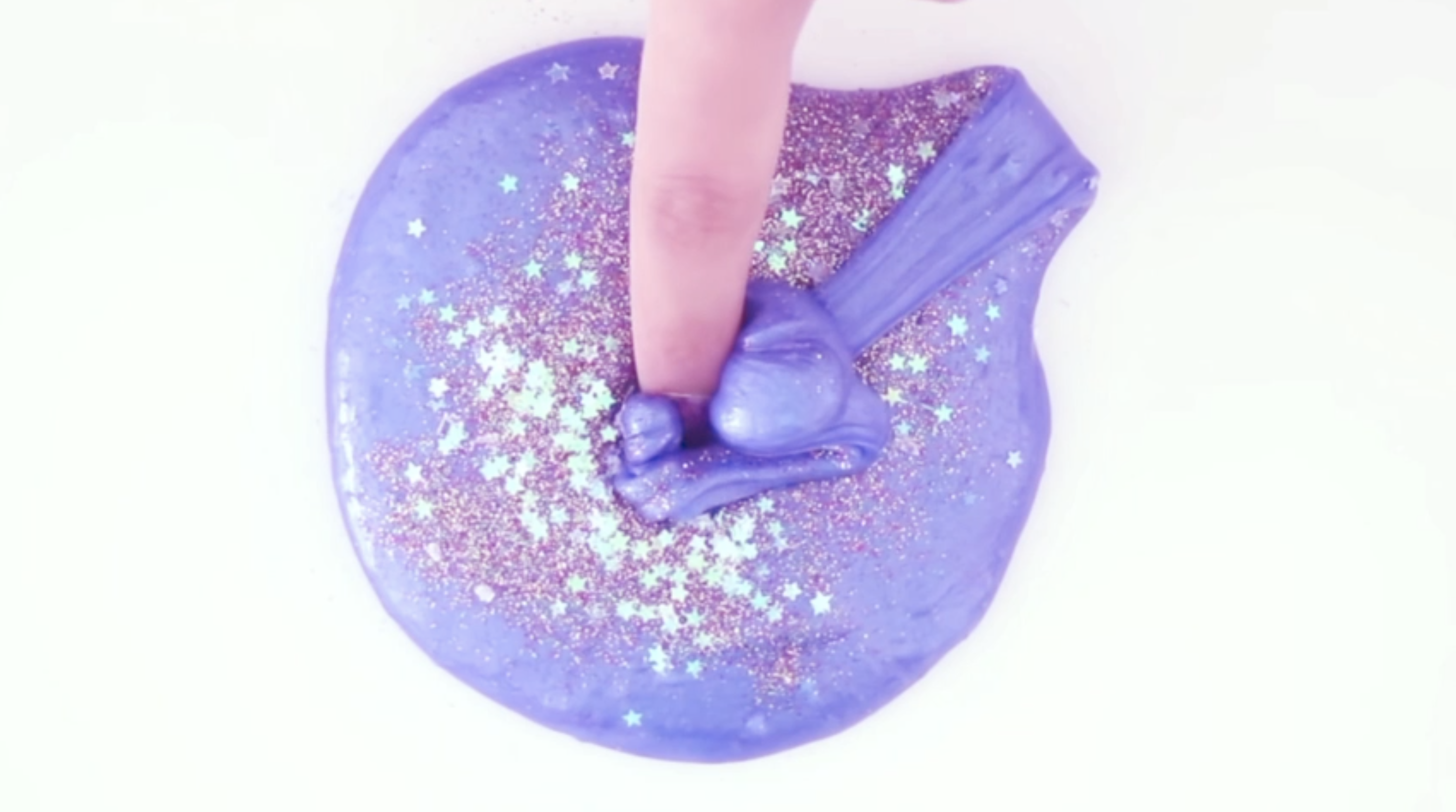

Photography: Antonia Gangi
Attendant Writing
A three-hour workshop which nurtures awareness and presence through writing, primarily in outdoor settings.
Attendant Writing offers space to actively experiment with different writing exercises that can help us to deepen our attention to the world around us, and to our relationships with place and other beings. The words ‘attention’ and ‘attending’ are rooted in the idea of stretching oneself – or one’s mind – towards something. These words are related to tenderness, tendrils, tension, and sustaining. What are we extending ourselves towards? Which new or renewed relationships do we want to foster?
The workshop was first held between LOT Projects and Haggerston Park, East London, in August 2023. It was originally commissioned by Nastia Svarevska to accompany Sabīne Šnē’s exhibition, To Be We Need to Know the River. An adapted version was held in November 2023 at Glengall Wharf Garden – a community garden in the heart of Peckham, South London.

Photography: Fiona Glen
Sporing Poetry
Site-specific eco-writing workshop in collaboration with Nina Hanz at Floating University in Berlin.
Nina and I had recently published Mycoglossia, a poetry chapbook that ‘speaks through many mushroom voices’, asks how language might ‘move like spores’, and draws on the intimate collaboration of fungi. In this workshop, we wanted to share some of our approaches to letting go of individual authorship, and invite participants to experiment with writing in a more collective manner.
Over an afternoon in August 2023 at Floating – an anti-university located in the rainwater collection basin of Berlin’s former Tempelhof airfield – we invited participants to write from the landscape, to exchange fragments or ‘spores’ of their texts, and to generate a collective poem through a highly participatory process.
The group’s final poem was read by two participants before an artists’ lecture which Nina and I staged at Floating that evening. My attendance was made possible by the Drusilla Harvey Access Fund for writers’ travel costs.
 .
. 

All photography by Hydar Dewachi
HUM, MURMUR, MUTTER
An experimental writing course which explored the connections between voice, body and text. Commissioned by and hosted at Camden Art Centre, London, in November-December 2022, the course spanned five two-hour sessions.
Testing out many voices and connecting with embodied modes of writing, the aim of this course was to surprise ourselves: to write into the unknown, so that we could encounter our writing from a new angle. HUM, MURMUR, MUTTER journeyed through poetry, essay, fiction, libretto, writing for voice, and interdisciplinary forms which resist classification.
Starting by investigating our inner voices, we moved outwards to confessions and addresses, to songs and shouts, to choruses and cacophonies. We pushed our written voices into new places and modes – sharper and softer, lighter and weightier, bolder and subtler.
Rather than focussing on producing a finished body of work, the course prioritised helping writers to break out of habits and perceived limitations – discovering new routes and courage which they could continue to build on in the long term. All participants were invited to share their work as part of an organic critique session, and given the option of contributing to a collaboratively-edited zine. You can download and read this publication here, on Camden Art Centre’s website.
How can a text speak?
How can we use its weight, texture, tone, shape, flow,
direction, and resonance?

Highlights according to participants:
“Sharing and listening to other attendees’ work, the array of different artists Fiona showed us, and the experimentation that she encouraged.”
“Being introduced to a lot of new methods that I would have found intimidating to look at alone. Fiona was a really supportive teacher.”
“The open, non-judgmental writing space that Fiona created, and her diverse readings and sources.”
“Learning to think about text in multiple new and out-of-the-box ways, and gaining tools for using voice, image and sound.”
The course scored 100% on teaching, value for money, and overall quality.



 Installation view, Allison Katz, Artery at Camden Art Centre, 2022
Installation view, Allison Katz, Artery at Camden Art Centre, 2022Inside Your Mouth Are Mountains
A three-week experimental art writing course commissioned by Camden Art Centre, London, in early 2022. IYMAM encouraged participants to experiment with a more physical type of writing, as we wrote from objects, artworks and bodily experiences.
The course explored voicing the material and translating the sensory into text, using techniques from embodied, associative, experimental, and ekphrastic writing. Everyone was invited to share their work, feed back on others’ writing, and support one another to try new avenues. Sessions drew on Allison Katz’s exhibition, Artery, and encouraged participants to write in dialogue with the artist’s paintings.
Across the three three-hour sessions – respectively focussed on objects, artworks and bodies – we considered writing as a bodily act and the body as a thinking entity, moving from cerebral and ‘disembodied’ visions of writing and into our senses, and taking a craft-based approach to writing. How can we use text like a visual medium, and in conspiracy with visual art? How can our writing move towards involved correspondence with artworks?
At the end of the course, I compiled a zine of our texts, which you can read and download here, on Camden Art Centre’s website. The course title is taken from ‘to speak of flying’, a poem by Maia Elsner.
Writing Objects
Writing Artworks
Writing Bodies
Feedback from participants:
“The course expanded possibilities and was nourishing and generative. Fiona creates a very supportive atmosphere which feels precious, and really helped me to flourish.”
“I loved everything I learned, including new ways of looking at art, and how to write from painting and dancing. Fiona was a wonderful teacher. I wish it was a long-term course!”
“It was a privilege to participate. The course was considered, ambitious and expansive. I’ve been introduced to so many writers and projects.”
“Fiona was amazing. I appreciated the pronoun check-in and the wonderfully open atmosphere. I loved being freed from the idea of writing as cerebral, and encouraged to write differently.”


Graphic: Fiona Glen
Gut Feelings
Experimental writing workshop on digestion and the gut, created and facilitated in collaboration with fellow artist and writer, Esme Boggis. Gut Feelings was commissioned and hosted in autumn 2021 by TACO! – an independent art space in Thamesmead, London, UK.
In this four-hour collaborative session, Esme and I offered a creative and open space for participants to discuss materials, write, and share reflections. All were then invited to present their pieces publicly through a newspaper-style zine publication – ’The Digest Reader’ – which I compiled and designed. You can find out more about this mini-publication here. The Reader was launched with a live showcase at TACO! in December 2021, which included readings, film and sound performances.
Our gut is lengthy, weighty, coiled tightly in the core of our bodies. It is forever present but out of sight, gurgling and growling, communicating its digestive processes. What if we found opportunities for the body to speak for itself, allowing the unsung parts to bellow? What if we engaged with digestion through a metabolic form of writing?
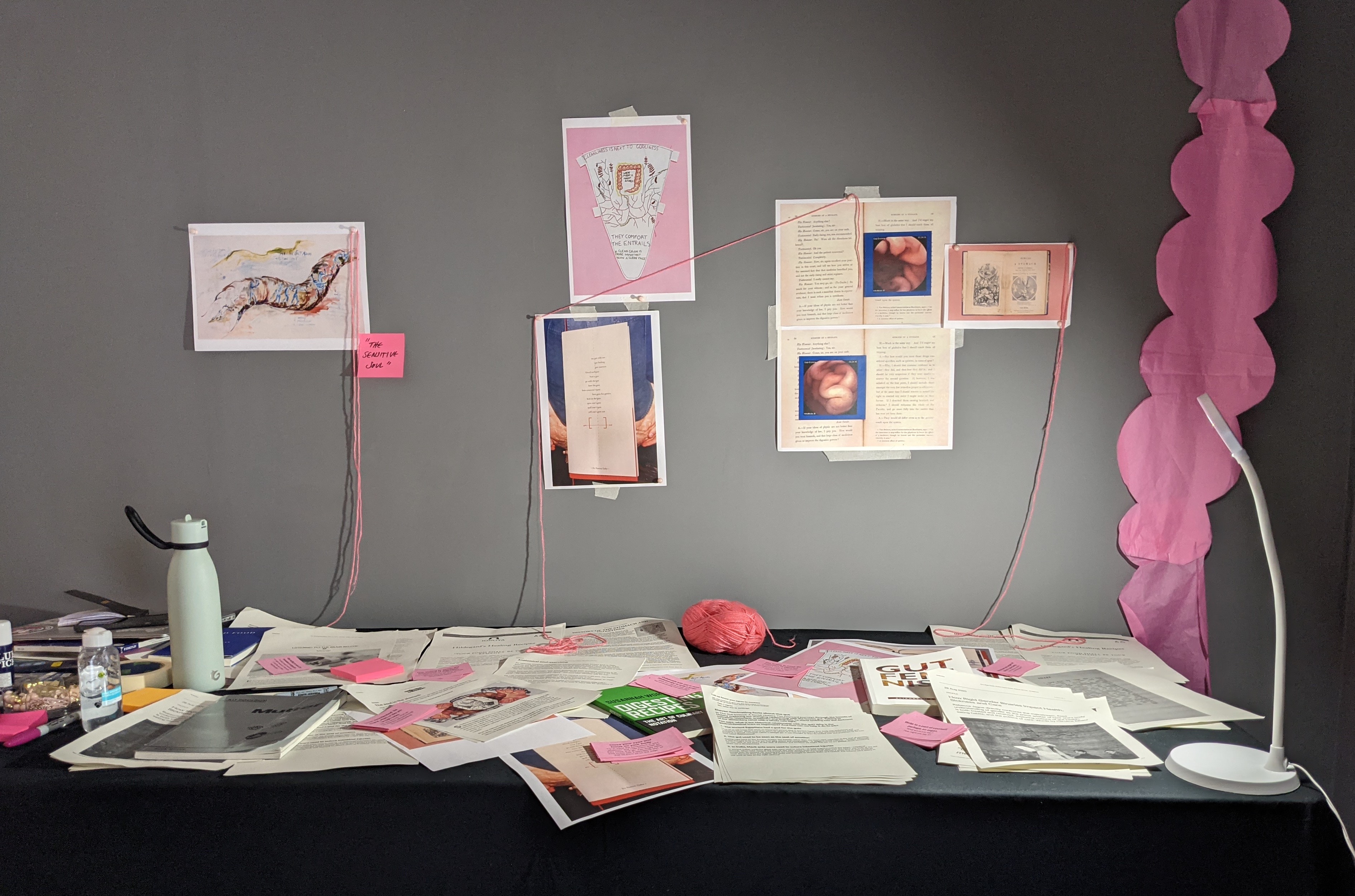

Use writing to mimic the
movement of digestion.
You might use words for their sounds, or how they look, or their descriptive
effect.
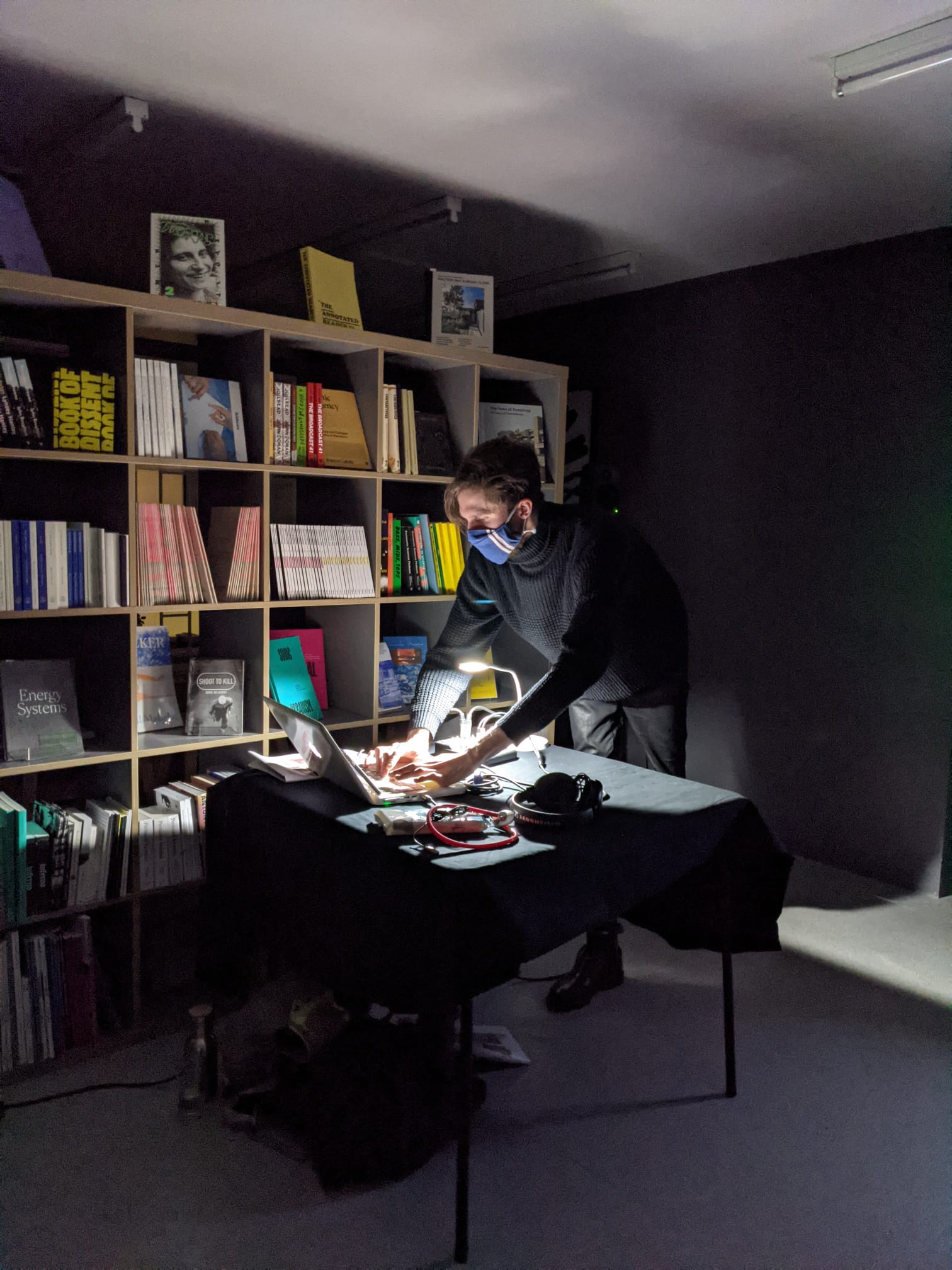

Images: Fiona Glen and Esme Boggis

